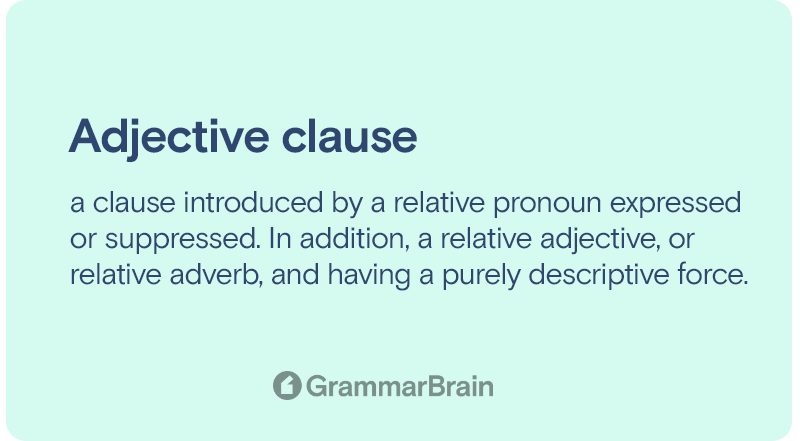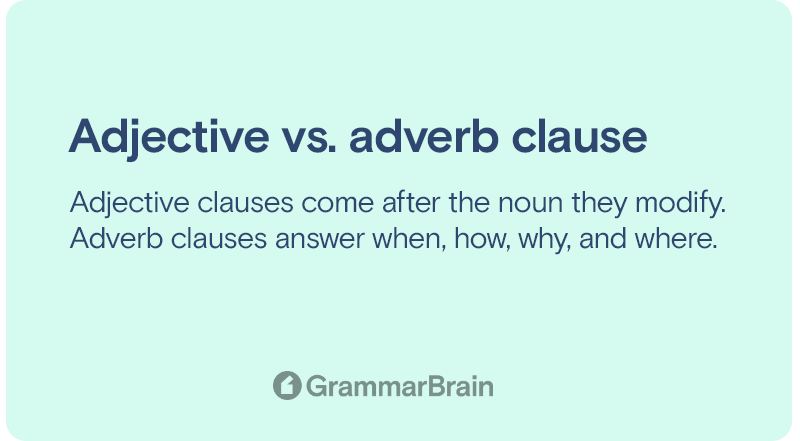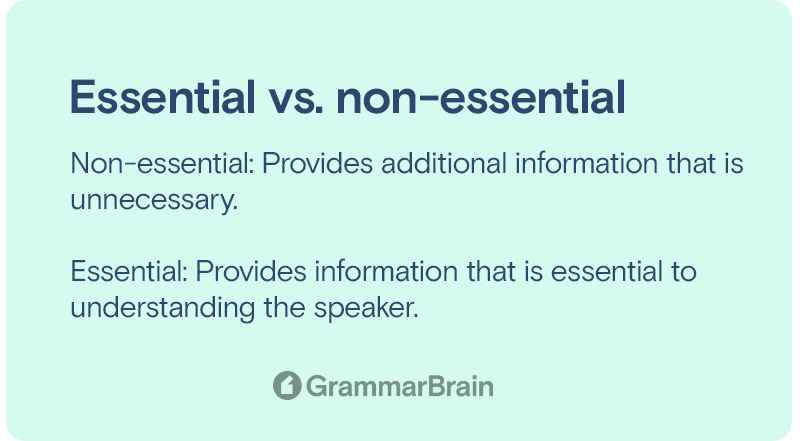What is an adjective clause? How do adjective clauses work? Including adjective clauses in your writing is an excellent approach to conveying more information about the pronouns and nouns. This additional information will enhance your work and assist the reader in grasping your point better. When you understand relative pronouns and know how to differentiate between non-essential and essential clauses, you’ll have little or no issue recognizing adjective clauses in your work.
So, before we go into the subtleties of adjective clause application, let’s first define adjective clause.

What is an adjective clause?
A relative clause, also known as an adjective clause, is a dependent clause that characterizes a noun in a sentence. Despite the fact that it’s comprised of many words rather than just one, it serves as an adjective. Every single word in an adjective clause works together to modify the pronoun or noun.
Now that you understand what an adjective clause means, it may be helpful to look at some instances of adjective clauses to help you better comprehend this idea.
Adjective clause definition
“A relative clause is a sentence, an earlier noun, or part of a sentence,” according to the Oxford Learner’s Dictionary. The Collins Dictionary defines an adjective clause as “a relative phrase that modifies a pronoun or noun.”
Merriam-Webster Definition describes an adjective clause as “a clause introduced by a relative pronoun expressed or suppressed. In addition, a relative adjective, or relative adverb, and having a purely descriptive force.”
Examples
- The flowers that we bought last week have perished.
- My friend, who wears glasses, was absent from school today.
- The kid, who pretended to have a fractured arm, was lying.
- Danny’s cat, who ate the mice yesterday, is sick.
- The thief, who committed a robbery in our house, is in prison now.
In the above examples, the flowers that have perished can also be a complete sentence, and it’s not dependent. But the adjective clause “that we bought last week” gives additional information about the noun “flower.”
Here you can see that “that we bought last week” is not a single word but a group of words. And that specialty makes them adjective clauses, not adjectives.

How is an adjective clause different from other clauses?
Although this article has many different types of clauses, we will only go into the details of adjective clauses, noun clauses, and adverb clauses.
Regarding similarities between adjective clauses, adverb clauses, and noun clauses, they both have a verb and a subject. Yet, it does not communicate a complete sentence and cannot stand on its own as a sentence, but there are some fundamental differences.
Let’s first understand adjective clauses
Adjective clause
A relative clause is another name for an adjective clause. It has a verb and a subject but does not communicate a complete sentence and, therefore, can’t exist as a sentence. This sentence serves as a description as well as an adjective. Adjective clauses come after the noun they are modifying.
Look at some instances of adjective clauses to help you better comprehend this idea.
Examples:
- The children who reside in my neighborhood go to school by bus. (Children Modified)
- John, who is my best buddy, lives in that apartment. (John modifies)
- Mary, whose dad is an English professor, is my English tutor. (Mary modifies)
Adverb clauses
An adverb clause both describes and acts as an adverb. It has a verb and a subject but does not communicate a complete sentence and cannot stand on its own as a sentence. Adverb clauses answer when, how, why, and where questions. Subordinating conjunctions are used to begin adverb clauses.
Look at some instances of adjective clauses to help you better comprehend this idea.
Examples:
- Text me when you reach home. (Answers when)
- I was cooking supper while the children were running in the park. (Answers when)
- This is the location where they murdered john. (Answers where)
- Bring extra clothing since there is a get wet at sea. (Explains why)
- I’ll give you a bar of chocolate if you tell me their secret. (Explain how)
Noun Clauses
A noun clause functions like a noun. It has a verb and a subject but does not communicate a complete sentence and cannot stand on its own as a sentence. Pronouns or subordinating conjunctions begin noun clauses.
Look at some instances of adjective clauses to help you better comprehend this idea.
Examples:
- That shop is where I purchased your favorite sneakers.
- John is the one person who knows all my secrets.
- It would be best if you decided which hotel we go to tonight.
- We were away because my car got pincered on the road.
Components of an adjective clause
Adjective clauses are made up of several components.
Adjective clauses in a sentence are dependent clauses that are a collection of words consisting of a verb and a subject.
However, it is not complete thought that can exist alone. The adjective clause usually begins with a relative pronoun, although it can be removed, and they come after the noun they describe.
Above all, adjective clauses give extra information about the noun.
Relative pronoun and adjective clause
Identifying an adjective clause in a phrase is simple if you recognize relative pronouns. Adjective clauses start with a relative pronoun that links it to the thing they describe. The terms where, that, who, whom, who, which, whose, and why are examples of relative pronouns.
Look at some instances that will help you better comprehend this idea.
Examples:
- Chocolate, which many individuals appreciate, is full of calories.
- Citizens, who are intelligent, follow the constitution in its letter and spirit.
- I remember those days when smartphones did not exist.
- Peter has a buddy whose daughter is in India.
- The wine that is produced by Tuscan distillers is not inexpensive.
- The reason why jack went to medical school is that he didn’t want to be a lawyer.
Each adjective phrase starts with a relative pronoun. This links it to the noun having described, which appears immediately before a relative pronoun in the expression.
Grammar rules of an adjective clause
Each adjective sentence has a subject and a verb that work together to define the underlying noun being changed.
For example, the clause “which many people appreciate” comprises the subject individual and the verb appreciate.
However, it is not a complete sentence on its own.
Instead, it expands on the word chocolate in the phrase, “Chocolate, which many individuals appreciate, is full of calories.”
In certain circumstances, the relative pronoun acts as the clause’s subject. In the adjective phrase “who are intelligent,” for example, the relative pronoun, i.e., “who,” also serves as the subject.

Essential vs. Non-Essential Adjective Clauses:
Essential Adjective Clauses
Sometimes the content included in an adjective clause is critical to the meaning of the phrase, while other times, it is not.
So, the adjective clause is said to as an essential clause when the phrase would not have the same effect without it.
- For instance, “I don’t like children who eat chocolates with dirty hands.”
A necessary adjective clause does not require additional punctuation, which is a straightforward identification method. In this situation, the adjective phrase provides crucial information about which children the speaker dislikes.
If you removed that clause, the sentence would state, “I don’t like children.” Which is not the same as not liking children who eat chocolate with dirty hands!
Non-Essential Adjective Clauses:
A non-essential adjective clause, on the contrary, provides additional information that is unnecessary for understanding the speaker’s purpose.
- For instance, “the puppy, who was the smallest, eventually found a home.”
The adjective phrase provides more information in the above example. However, it is not required to understand the substance of the statement about the puppy finding a home.
Commas separate non-essential adjective clauses to indicate that they are not as tightly linked to the remainder of the phrase.
FAQs
What exactly is an adjective clause?
An adjective clause is a clause that functions in the sentence similarly to an adjective. It is also known as relative clauses.
What exactly is the distinction between an adjective clause and an adjective phrase?
The fundamental distinction between an adjective clause and an adjective phrase is that an adjective phrase might contain an adjective. However, an adjective clause does not have to contain an adjective to be classified as an adjective clause. Another distinction is that an adjective clause contains a pronoun/noun and a verb.
What are the different kinds of adjective clauses?
Nonessential and Essential adjective clauses are the two sorts of adjective clauses.
Why are adjective clauses important?
Including adjective clauses in your writings is an excellent approach to conveying more information about the pronouns and nouns. This additional information will enhance your work and assist the reader in grasping your point better.
Inside this article
Fact checked:
Content is rigorously reviewed by a team of qualified and experienced fact checkers. Fact checkers review articles for factual accuracy, relevance, and timeliness. Learn more.
Core lessons
Glossary
- Abstract Noun
- Accusative Case
- Anecdote
- Antonym
- Active Sentence
- Adverb
- Adjective
- Allegory
- Alliteration
- Adjective Clause
- Adjective Phrase
- Ampersand
- Anastrophe
- Adverbial Clause
- Appositive Phrase
- Clause
- Compound Adjective
- Complex Sentence
- Compound Words
- Compound Predicate
- Common Noun
- Comparative Adjective
- Comparative and Superlative
- Compound Noun
- Compound Subject
- Compound Sentence
- Copular Verb
- Collective Noun
- Colloquialism
- Conciseness
- Consonance
- Conditional
- Concrete Noun
- Conjunction
- Conjugation
- Conditional Sentence
- Comma Splice
- Correlative Conjunction
- Coordinating Conjunction
- Coordinate Adjective
- Cumulative Adjective
- Dative Case
- Determiner
- Declarative Sentence
- Declarative Statement
- Direct Object Pronoun
- Direct Object
- Diction
- Diphthong
- Dangling Modifier
- Demonstrative Pronoun
- Demonstrative Adjective
- Direct Characterization
- Definite Article
- Doublespeak
- False Dilemma Fallacy
- Future Perfect Progressive
- Future Simple
- Future Perfect Continuous
- Future Perfect
- First Conditional
- Irregular Adjective
- Irregular Verb
- Imperative Sentence
- Indefinite Article
- Intransitive Verb
- Introductory Phrase
- Indefinite Pronoun
- Indirect Characterization
- Interrogative Sentence
- Intensive Pronoun
- Inanimate Object
- Indefinite Tense
- Infinitive Phrase
- Interjection
- Intensifier
- Infinitive
- Indicative Mood
- Participle
- Parallelism
- Prepositional Phrase
- Past Simple Tense
- Past Continuous Tense
- Past Perfect Tense
- Past Progressive Tense
- Present Simple Tense
- Present Perfect Tense
- Personal Pronoun
- Personification
- Persuasive Writing
- Parallel Structure
- Phrasal Verb
- Predicate Adjective
- Predicate Nominative
- Phonetic Language
- Plural Noun
- Punctuation
- Punctuation Marks
- Preposition
- Preposition of Place
- Parts of Speech
- Possessive Adjective
- Possessive Determiner
- Possessive Case
- Possessive Noun
- Proper Adjective
- Proper Noun
- Present Participle
- Prefix
- Predicate



